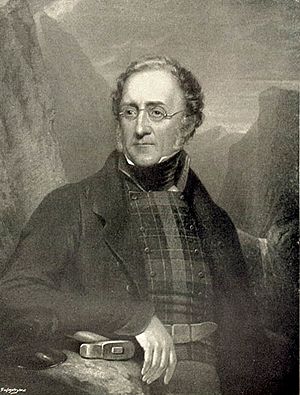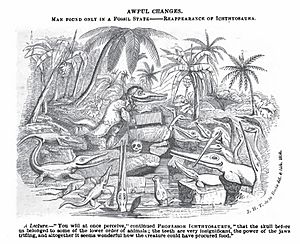Henry De la Beche facts for kids
Quick facts for kids
Henry De la Beche
|
|
|---|---|
 |
|
| Born | 10 February 1796 |
| Died | 13 April 1855 (aged 59) |
| Nationality | English |
| Known for | Painting Duria Antiquior – A More Ancient Dorset |
| Awards | Wollaston Medal (1855) |
| Scientific career | |
| Fields | Geology, palaeontology |
| Institutions | Geological Survey of Great Britain |
Sir Henry Thomas De la Beche (born February 10, 1796 – died April 13, 1855) was an important English geologist and paleontologist. He was the very first director of the Geological Survey of Great Britain. He helped create new ways to study and map the Earth's rocks and history. He also led the Palaeontographical Society, which studies ancient life.
Contents
About Henry De la Beche
Henry De la Beche was born in London, England. As a child, he lived with his mother in Lyme Regis. This is where he became very interested in geology. He became friends with Mary Anning, a famous fossil hunter.
When he was 14, Henry went to the Royal Military College. But after 1815, his path changed. At 21, he joined the Geological Society of London. He loved collecting and drawing fossils. He worked with another geologist, William Conybeare, on a paper about ichthyosaur and plesiosaur bones. This paper was presented in 1821.
Henry was a very active member of the Geological Society. He was even its president from 1848 to 1849. He traveled a lot to study geology. He visited places in Britain, France, and Switzerland. He also went to Jamaica in 1823–1824. There, he studied the geology of the island and wrote about it in 1827.
After returning to England, he began studying the rocks in Cornwall and Devon. He saw how important it was to understand the country's mineral resources. This gave him the idea that Britain needed a national geological map. He also thought it was important to collect and keep rock and fossil samples.
Starting the Geological Survey
Henry De la Beche suggested that the government should create a geological map of the United Kingdom. The government agreed and asked him to work with the Ordnance Survey. This was the beginning of the Geological Survey of Great Britain. It officially started in 1835, and Henry De la Beche became its first director.
He also became the first director of the Museum of Practical Geology. This museum opened in 1843. Henry donated many of his own books to start the museum's library.
The museum quickly grew too big for its first home. Henry asked the government for a larger building. He wanted to expand the scientific work of the Survey. Parliament approved a new museum in Jermyn Street, London. This new building would also house the Geological Survey offices, the Royal School of Mines, and the Mining Record Office. The new center opened in 1851.
Henry De la Beche's Writings
Henry De la Beche wrote many important books and papers about geology. In 1830, he published Sections and views, illustrative of geological phaenomena. This book had drawings to help people make better pictures of rock formations.
He also wrote many reports on English geology. One famous report was Report on the Geology of Cornwall, Devon and West Somerset (1839). Other books include A Geological Manual (1831) and Researches in Theoretical Geology (1834). In these books, he shared advanced ideas about geology. His book How to Observe Geology (1835) was later rewritten as The Geological Observer (1851).
Henry De la Beche was also involved in the "Great Devonian Controversy." This was a big debate among geologists about the age of certain rocks. He sometimes used funny cartoons to share his thoughts on this and other topics.
Honors and Legacy
Henry De la Beche was recognized for his important work. He became a Fellow of the Royal Society in 1819. He was knighted in 1842, which means he received the title "Sir." Near the end of his life, he received the Wollaston Medal, a very high award in geology. In 1852, he was chosen as a foreign member of the Royal Swedish Academy of Sciences.
Henry De la Beche is buried in the Kensal Green Cemetery in London.
Cartoons and Art
Henry De la Beche was a big supporter of Mary Anning's work. In 1830, he drew a famous sketch called Duria Antiquior – A More Ancient Dorset. This drawing showed the ancient sea creatures Mary Anning had found, like ichthyosaurs and plesiosaurs. It was one of the first pictures to show what life might have looked like in ancient times.
Mary Anning was having money problems, so Henry helped her. He made prints of his drawing and gave her the money from selling them. This helped her continue her important fossil work.
Henry De la Beche was a great scientist who also had a sense of humor. He sometimes made fun of strange ideas of his time. For example, some people believed that ancient life forms would return to Earth. In 1830, he drew a cartoon called Awful Changes. It showed an ichthyosaur professor teaching about a fossilized human skull. The professor says the skull belonged to a "lower order of animals" with "insignificant" teeth. This cartoon showed how silly some of these ideas were.
Family Life
Henry De la Beche married Letitia Whyte in 1817. They had two daughters. Their daughter Elizabeth (1819–1866) married Lewis Llewelyn Dillwyn. He was a scientist and a member of Parliament. Elizabeth helped design pottery. They had four children, including Mary De la Beche Nicholl, who was an alpinist and studied butterflies, and Amy Dillwyn, who became a novelist.
Geographic Features Named After Him
Several places are named after Henry De la Beche to honor his contributions to geology:
- Mount De La Beche in New Zealand
- De la Beche Bay in Nunavut
See also
 In Spanish: Henry de la Beche para niños
In Spanish: Henry de la Beche para niños
Images for kids







